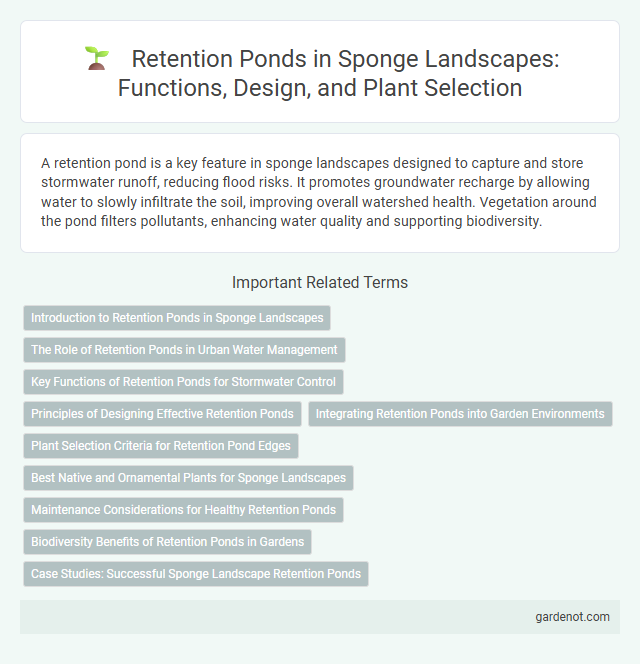A retention pond is a key feature in sponge landscapes designed to capture and store stormwater runoff, reducing flood risks. It promotes groundwater recharge by allowing water to slowly infiltrate the soil, improving overall watershed health. Vegetation around the pond filters pollutants, enhancing water quality and supporting biodiversity.
Introduction to Retention Ponds in Sponge Landscapes
Retention ponds play a critical role in sponge landscapes by capturing and storing stormwater runoff to reduce flooding and enhance groundwater recharge. These engineered basins are designed to hold water temporarily, allowing sediments and pollutants to settle before the water is gradually released or absorbed. Integrating retention ponds within sponge landscapes improves urban resilience by managing excess water sustainably while supporting local ecosystems.
The Role of Retention Ponds in Urban Water Management
Retention ponds play a critical role in urban water management by controlling stormwater runoff, reducing flood risks, and improving water quality. These engineered basins capture and hold excess rainwater, allowing sediments and pollutants to settle before the water is gradually released or infiltrated. Implementing retention ponds in urban landscapes enhances groundwater recharge, mitigates erosion, and supports sustainable urban drainage systems.
Key Functions of Retention Ponds for Stormwater Control
Retention ponds play a crucial role in stormwater management by capturing and storing runoff to reduce flooding risks and prevent erosion. These ponds facilitate sedimentation, improving water quality by allowing pollutants and sediments to settle before water is gradually released. They also support groundwater recharge and contribute to urban biodiversity by providing wetland habitats.
Principles of Designing Effective Retention Ponds
Effective retention pond design relies on maximizing stormwater capture while preventing overflow and erosion. Incorporating gradual slopes, adequate storage volume, and native vegetation enhances pollutant filtration and habitat creation. Regular maintenance ensures sustained water quality and structural integrity, promoting long-term environmental benefits in sponge landscapes.
Integrating Retention Ponds into Garden Environments
Retention ponds enhance garden environments by effectively managing stormwater runoff and promoting groundwater recharge. Incorporating native aquatic plants around retention ponds improves water quality and supports local biodiversity. Properly designed retention ponds blend functionality with aesthetic appeal, creating sustainable and visually pleasing garden landscapes.
Plant Selection Criteria for Retention Pond Edges
Effective plant selection for retention pond edges involves prioritizing native species with deep root systems to enhance soil stabilization and reduce erosion. Plants should tolerate fluctuating water levels and seasonal inundation while providing habitat for local wildlife. Selecting species with high pollutant uptake capabilities supports water quality improvement and ecosystem sustainability in sponge landscape design.
Best Native and Ornamental Plants for Sponge Landscapes
Retention ponds in sponge landscapes benefit from native plants like Switchgrass (Panicum virgatum) and Blue Flag Iris (Iris versicolor), which enhance water absorption and sediment filtration. Ornamental species such as Cattails (Typha latifolia) and Rain Lilies (Zephyranthes spp.) offer aesthetic value while promoting nutrient uptake and habitat diversity. Combining these plants supports optimal stormwater management and ecological balance in retention pond systems.
Maintenance Considerations for Healthy Retention Ponds
Retention pond maintenance requires regular inspection to manage sediment buildup, control invasive vegetation, and ensure proper water flow. Routine removal of debris and accumulated sediment improves water quality and prevents clogging of outlet structures. Proper vegetation management and erosion control protect the pond's functionality and enhance its role in stormwater management.
Biodiversity Benefits of Retention Ponds in Gardens
Retention ponds in gardens create essential habitats that support diverse aquatic and terrestrial species, enhancing local biodiversity. These ponds provide breeding grounds for amphibians, attract pollinators like bees and butterflies, and support birds and beneficial insects, contributing to a balanced ecosystem. Integrating retention ponds into garden landscapes promotes natural pest control and improves overall ecological resilience.
Case Studies: Successful Sponge Landscape Retention Ponds
Case studies demonstrate that successful sponge landscape retention ponds efficiently manage stormwater runoff, reduce urban flooding, and enhance groundwater recharge by integrating permeable soil layers and native vegetation. Projects such as the Singapore Marina Bay and Portland's Tanner Creek illustrate how strategic design and maintenance promote biodiversity while improving water quality. Data from these examples reveal a reduction in peak runoff rates by up to 40% and increased infiltration rates exceeding 200 mm/hour.
Retention pond Infographic

 gardenot.com
gardenot.com